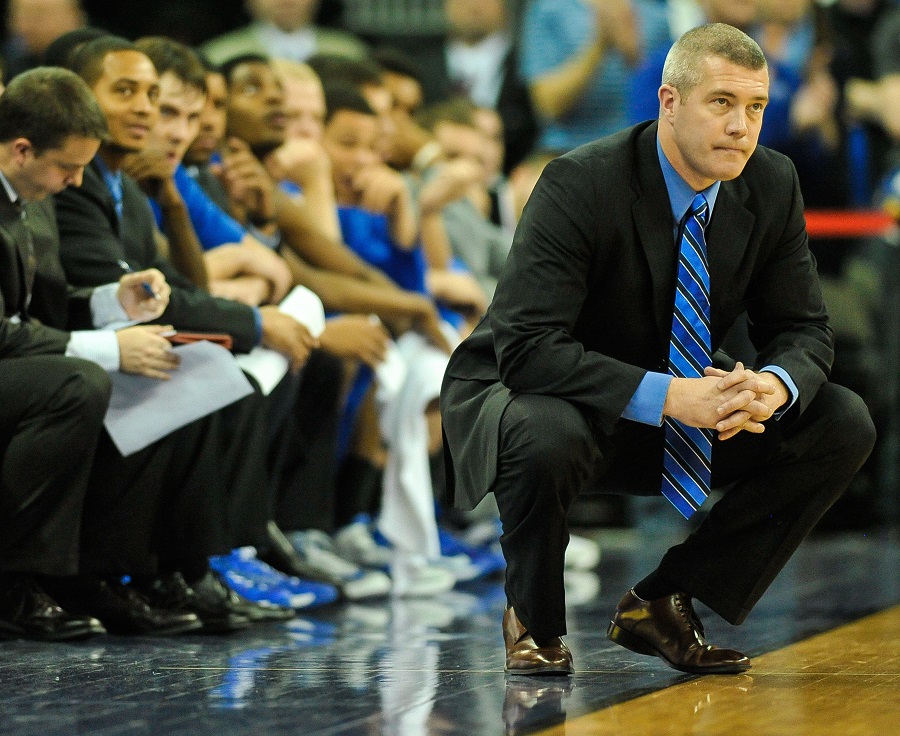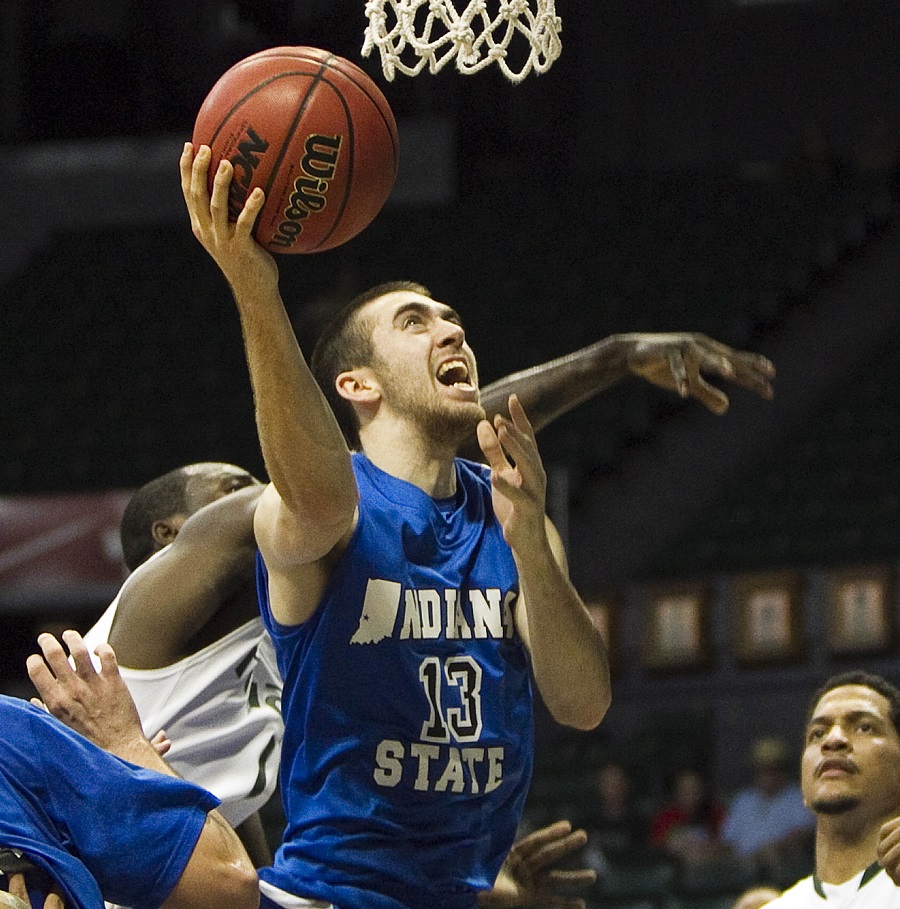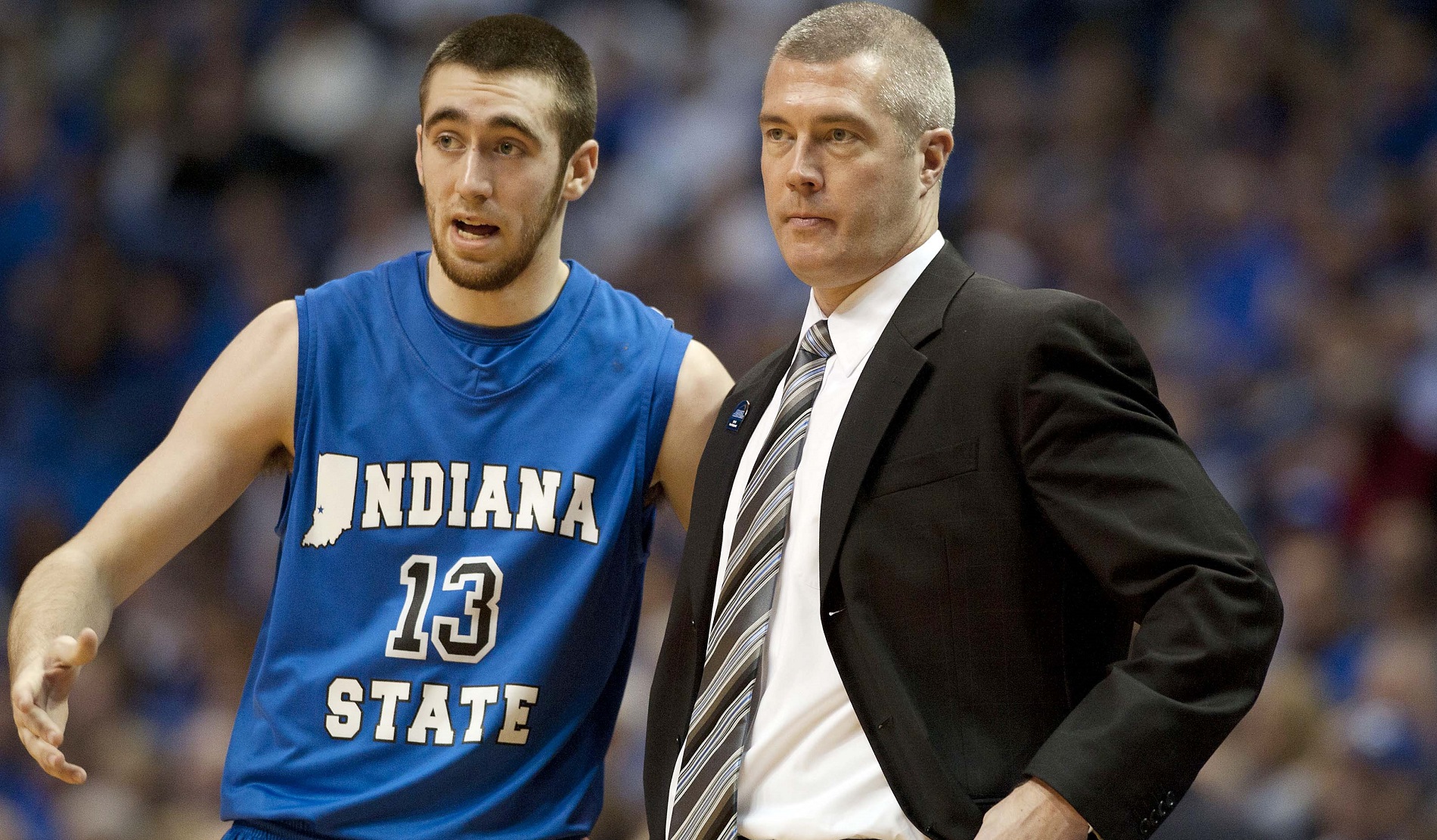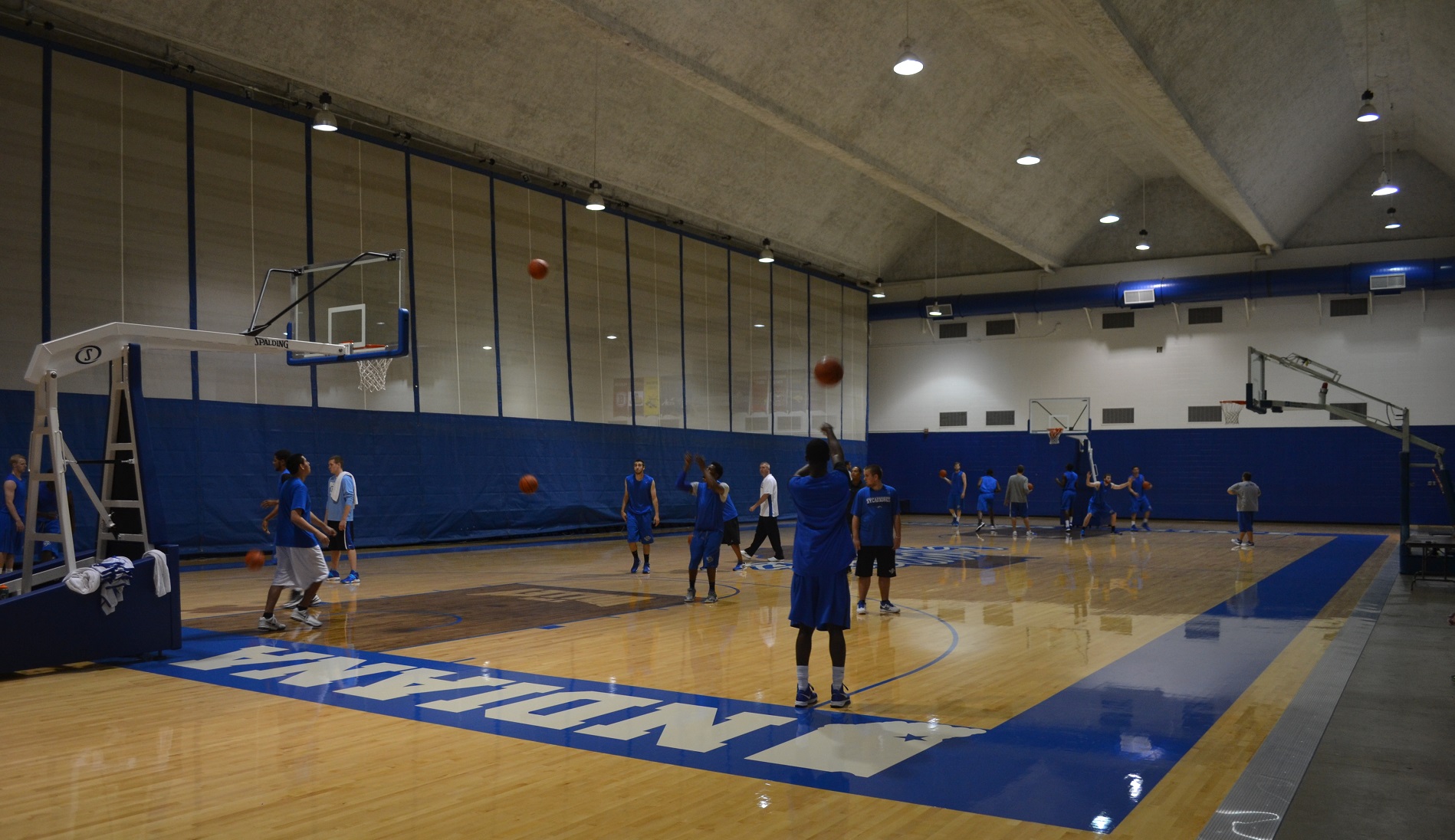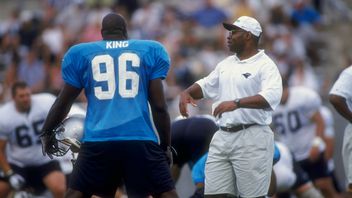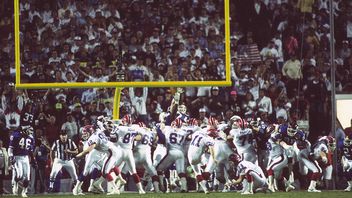Greg Lansing looked beat. The coach of Indiana State's men's basketball team normally comes across as disciplined and intense. With his buzz-cut gray hair, he seems to belong in one of two places -- either in front of the bench at a big-time arena or at the local strip mall, his unit's most successful Army recruiter.
But Lansing had just watched his team lose to Iowa in the first round of the 2013 National Invitation Tournament. While the Sycamores' season had included plenty of good -- beating No. 13 Creighton at home, beating No. 14 Wichita State on the road -- tonight had been mostly bad, particularly in the second half, when the team had earned an embarrassing technical foul for having six players on the floor.
Now Lansing had to slog through his press conference. The reporters lobbed leading questions, eager to fill the blanks in their game stories and get home. ("Greg, can you talk about the lack of concentration ... and how disappointing that is?") As the interrogation continued, Lansing began looking a little distracted himself. But then, without any real prompting, he started to muse on something that cheered him up: "These are -- we don't have a senior," the coach said. "We're going to be a good team."
* * *
Everyone knows what a Cinderella looks like in March: the team that's a little shorter and a little slower hits the last-second shot. Their bench, shorter and slower still, storms the court, bursting with all-downhill-from-here endorphins.
This is what a Cinderella looks like in September: It's an ugly day at the Idle Creek Golf Course outside Terre Haute, a mix of summer's mugginess and fall's cloudy skies. Ray Goddard, the course's profoundly tanned pro, has just erected a small "Indiana State University Welcomes You" banner in front of the clubhouse. Today is the basketball team's annual golf scramble. The course's blue pins make a perfect match for the bright, "Pantone 293" blue in the Sycamores' colors, though that's just a coincidence.
As Goddard steps back to check his work, Lansing pulls up in a golf cart. The coach points at two new golf bags in his cart. "What do you think of giving these away for closest to the pin?" he says.
"Well, you gotta give ‘em something," Goddard replies.
Lansing zips off to sort out the raffle and some other prizes, though not before he and Goddard tango through the following exchange:
Ray: "You're looking at the third-best coach in Indiana State history."
Greg: "Third best? I had more wins than John Wooden did in his first year!"
Ray: "Oh, I wasn't even counting Wooden - he was only here a year or two. So fourth best."
Greg: "Well, I never had you as a player."
John Wooden really did coach at Indiana State, winning 44 games before UCLA poached him in 1948. And Ray Goddard really was a terrific player, starring for the Sycamores from 1959-62 and even leading the country in free-throw percentage his senior year. Indiana State boasted a solid NAIA and Division II program, but when it jumped to Division I in 1969 the team struggled.
"It got to where you almost expected a losing season."
That all changed with the arrival of Larry Bird -- or was supposed to, anyway. "Indiana State may not be very good right now," Bird told his coaches, "but it will be when I get there." That was an understatement. In 1979, he took the Sycamores to the Final Four, where they lost in the final to Magic Johnson and Michigan State. Goddard says everyone assumed the team, which had recently joined the Missouri Valley Conference, would settle in as a consistent power, propped up by all in-state talent. Instead, the Sycamores went back to struggling, finishing 17 straight seasons at .500 or worse. "It got to where you almost expected a losing season," Goddard says.
In the late ‘90s, the program enjoyed a brief revival behind point guard Michael Menser and a few others. Even today, the 5'11 Menser looks like he should be a bag boy at IGA, but in 2000 he led Indiana State to its first March Madness since Bird. This time, however, the fans realized it didn't represent a lasting transformation so much as a temporary occurrence, the result of years of patience followed by a well-earned payoff. The next year, Menser and the Sycamores went dancing again and even upset fourth-seeded Oklahoma. But the moment Goddard remembers best is the guard draining two 3-pointers in eight seconds to beat Indiana University at Assembly Hall. "We've got more people in Terre Haute who are IU fans," Goddard says, leaning in close, "than are Indiana State fans."
This year, those Indiana State fans believe they're in for another potentially special season. Lansing, who is in his fourth year as head coach, has assembled a top-heavy roster. "We don't get blue-chip recruits, but we get pale blue chip," Goddard says, and the four juniors who started against Iowa are now seniors. "People are expecting big things," he adds. This Cinderella has scrubbed her fair share of floors, and her supporters want to see her go back to the dance.
For now, Lansing is busy dragging stray trash cans out of the way and checking one last time on the beer in the beverage carts. This event will draw about 120 golfers, an alarming number of them in sandals and socks. But at $600 for a foursome, it'll also go a long way toward getting the team to the schedule-boosting Great Alaska Shootout.
Idle Creek has a nice banquet facility, but the pre-golf lunch takes place in a garage-like annex with folding tables and plywood walls. Out front, the team manager hands out basketball schedules and encourages golfers to add a team-wide mulligan for only $20 more. A university administrator reminds everyone about the next fundraiser, where a Larry Bird statue will be dedicated.
The ghost of Bird hovers everywhere at the scramble. Dan Wolfe, who owns Wolfe's Auto Auction and is one of the program's biggest boosters, remembers the high-scoring "Larry and Harry Show," which featured Bird and forward Harry Morgan. "You couldn't get in the Hulman Center without season tickets," Wolfe says. Bob Heaton actually played on those teams and even hit a pair of last-second shots. But he wishes the crowds hadn't dropped off the second the Sycamores stopped winning. "I hate to use the word bandwagon," he says, "but that's what it was." The same pattern applied, on a smaller scale, to the Menser era. With the current squad, it barely applies at all. The annual high school game between Terre Haute South and Terre Haute North packs eight- or nine-thousand fans into Hulman. Sometimes the Sycamores, even with their recent success, draw only half that.
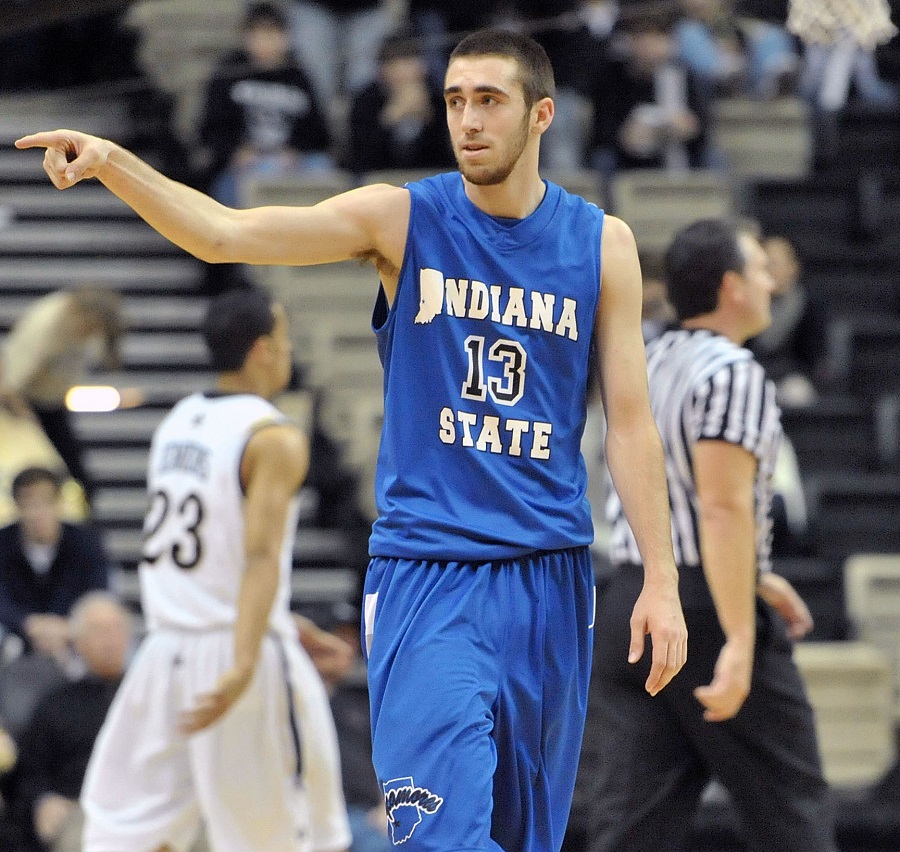 Jake Odum, Indiana State's star point guard. (USA Today Images)
Jake Odum, Indiana State's star point guard. (USA Today Images)
"We're thinking NCAA tournament this year. Even the NIT would be a disappointment."
Still, today has turned out a small but devoted core of ISU followers. Lansing works the crowd, nodding, listening, and backslapping. A few players loiter by the golf carts, notably All-Conference point guard Jake Odum. Odum looks like he's been beamed straight from the inside of a gym: high socks, baggy shorts, half-drank bottle of Orange Gatorade. The senior jokes with fans in his goofy, easy-going manner. At one point, even Bird's ghost makes an appearance -except it turns out to be Larry's brother Eddie, who has the same soft face and prominent nose. "They could use more fans," Eddie says, "but the community backs ISU."
Before long the buffet thins out and people start swapping their sandals for cleats. Odum jogs by, excited that some no-shows means he gets to golf. "I got picked up!" he crows. As the golf carts begin to pull out, Brent Compton reflects on the season ahead. He's wearing a Sycamores shirt and a Sycamores hat -- two of the many styles available at PaceSetter Sports, the local sporting goods store he operates. "We're thinking NCAA tournament this year," Compton says. "Even the NIT would be a disappointment." When asked how long he's been looking forward to the 2013-14 season, Compton answers immediately. He's been waiting on this season, for six full years -- ever since the first time he saw Odum lace up for the Terre Haute Jammers, an obscure AAU squad that turns out to be quite a story itself.
* * *
Terre Haute rests on the bank of the Wabash River, where the land is hillier than what you see in "Hoosiers," but only a little. Like many Midwestern cities, it's been hollowed out by interstates leading elsewhere (in this case, I-70) and by a decline in manufacturing. The presence of local universities -- Indiana State, plus a couple of private colleges -- keeps Terre Haute healthier than most similar cities, but only a little. It's the place where folks from the smaller towns in Indiana and across the border in Illinois drive to shop or eat or catch a movie.
Terre Haute is also where Jake Odum was born and raised. He never saw Indiana State as his destiny. "I just had nowhere else to go," he says. "I had no offers, no Division II offers, no junior college offers, nothing." Last year, Odum led the Sycamores in scoring (13.6 PPG) and assists (4.6) and nearly led them in rebounding (4.5). "That kid is as good a point guard as I've seen on film," Iowa's Fran McCaffery said after the NIT game. "I mean that sincerely." Yet Odum still clings to his underdog status. In fact, the only way to turn him serious is to tell him he can't do something -- or to get him to compile his slights. "So many people have told me that I wasn't good enough, that I couldn't do this or that," he says. "I'm just out to prove them all wrong."
Odum has cultivated this worldview basically from birth. At 6'4, he's long- and loose-limbed, with a scrawny build and a scraggly beard. (Lansing likes to tell reporters his star "looks like a skinny Amish kid.") He was even scrawnier as a kid, with a bigger and faster brother. "We had a sliver of pavement about the size of the paint," Odum recalls, and the two would play for hours. "I remember blood and tears from me," he says. "Not too much from him."
Once he got older, Odum started playing for school teams, though he still wasn't that good. As a freshman at Terre Haute South, he didn't even make JV. But in the summer of 2007, the year between his sophomore and junior years, he joined the AAU Terre Haute Jammers.
Brad Miley, who played forward at Indiana State with Bird, had started the Jammers a few years before. "It was primarily for my kids," he says, and the program drew its players from the 20 or so miles around Terre Haute. The team didn't enjoy a Nike or Adidas sponsorship -- unlike some other AAU teams, they didn't travel extensively or wear slick warm-up suits. Indeed, for most of the roster the notion of "jamming" was itself aspirational. "We had no Division I scholarships on our team," says Lucas Eitel, another ex-Jammer who walked on at Indiana State and is now a key shooter off the bench.
Still, the Jammers went on a stunning two-year run, regularly beating teams that boasted eight or nine future D-I players -- guys like Garrick Sherman (Michigan State), Evan Gordon (Arizona State), and DeShaun Thomas (Ohio State). "We played ‘Indiana-style basketball,'" Odum says (and those are his scare quotes). Most AAU teams play a fast-and-loose style that makes even NBA offenses seem elegant and unselfish. But the Jammers opted for a more structured, team-based approach, passing the ball, cutting constantly, chirping on defense.
It worked. "I don't think most of our opponents knew what hit them," Miley says. The Jammers' motives were never entirely pure. "If we play individually we don't beat them," Odum explains. "And then we're definitely not getting any looks from college coaches."
In 2008, Miley decided to take his team on the road. The Jammers scraped together enough cash to attend the Nike Main Event, a sprawling, four-division tournament in Las Vegas. To save money, the Jammers flew in on a brutal red-eye out of Indianapolis and played their first game that same day. "You could tell they were tired," Miley says, and the Jammers lost to a team from Oregon. Then they won their next eight straight, beating Dallas Showtyme and capturing the Gold Division title.
That summer, the Jammers went 44-5 and won five tournaments. Miley always uses a homemade version of the plus-minus statistic, and Odum dominated it. "But honestly, it didn't help us in getting recruited," the guard says. Even when the Jammers won, the coaches focused on their more physically gifted opponents. "We would have no coaches there watching us," Odum says. "None."
That's not quite true. There was often one college coach in the stands -- Greg Lansing. "Usually in July you're flanked by coaches on both sides and just talking," says Lansing, who had just started his second stint as a Sycamores assistant. "But during the Jammers' games you had to actually watch because no one was there." When more coaches did show up, to scout the other team, Lansing would propose an informal bet. The Jammers won him a lot of free dinners that way.
During Odum's senior year at Terre Haute South, Indiana State finally offered him a scholarship. "I just knew his teams would win," Lansing says. "That's what he's always done, and that's really all he cares about." The point guard arrived at Indiana State as a member of its most locally-sourced class in decades. In addition to Odum and the walk-on Eitel, there was also RJ Mahurin, a highly-recruited 6'8 forward from Rockville, one of those towns where people have to drive to Terre Haute. All three redshirted. "I hated that freshman year," Odum says, and his coaches recall how every time someone showed even a hint of a injury he would volunteer to ditch the redshirt -- right up to the season's final regular-season game.
In 2010, Odum finally made his Sycamore debut. It was also Lansing's first season as head coach, and the guard amazed even his most ardent supporters. "I thought he'd be good, help us out," says one of Lansing's assistants. "But not this."
What makes Odum so great? He's not a Michael Menser -- an archetypical efficient, smooth-shooting Indiana guard. Odum's shot remains a bit awkward, he's not that athletic, and even in high school he rarely blew past defenders. (On YouTube you can still find his highlights from Terre Haute South -- maybe the only recruiting tape in history that features a bounce pass hitting someone in stride.)
Instead, Odum succeeds through a paradoxical mix of superb instincts and sheer orneriness. It helps that he's grown, from 6'1 in high school to 6'4 today, and he now uses that height to find teammates and get his own shot. "It doesn't matter who you put around him," says Manny Arop, a forward for the Sycamores. "He'll adjust to your game." Odum also never stops competing. That can get him in trouble, especially on drives to the basket. But Odum does a bit of everything, and he does everything his way -- he's the kind of guy whose mitochondria have chips on their shoulders. Lansing still marvels at how the guard played his sophomore year with a stress fracture in one foot and plantar fasciitis in the other. "After one game against Minnesota," the coach recalls, "he took his shoe off and the bottom of his foot looked like it had been painted red -- just beet red."
It all adds up to the same style Odum used with the Jammers -- and, hopefully, to the same surprising results. Growing up in Terre Haute, he remembers how exciting it was when Menser's teams took off. Odum was still in middle school, and he and the other kids from homeroom would all go to games together. Terre Haute was like that back then. "Everywhere you went, you could hear the buzz," he says. Now he wants to bring that buzz back. "I probably won't ever leave Terre Haute, so I can't end on a bad note. People have been talking about Bird for 30, almost 40 years. I want the same thing."
